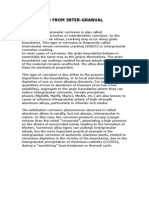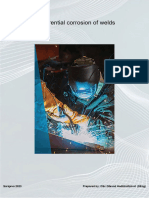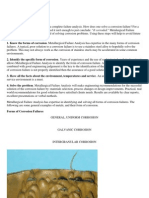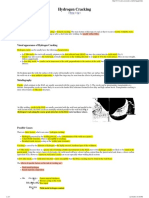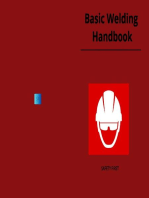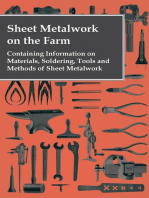0 ratings0% found this document useful (0 votes)
346 viewsWeld Decay
Weld Decay
Uploaded by
Said Alauddeen FaiszWeld decay is a form of intergranular corrosion that occurs in stainless steels and some nickel alloys due to sensitization caused by welding. The corrosion is restricted to the heat affected zone where welding temperatures caused chromium carbides to precipitate along grain boundaries, depleting chromium and making the zone susceptible to corrosion. Identification requires microscopy, but parallel lines can sometimes be seen visually in the heat affected zone. Chromium carbide precipitation during welding induces weld decay by consuming chromium from grain boundaries in the heat affected zone.
Copyright:
© All Rights Reserved
Available Formats
Download as DOCX, PDF, TXT or read online from Scribd
Weld Decay
Weld Decay
Uploaded by
Said Alauddeen Faisz0 ratings0% found this document useful (0 votes)
346 views1 pageWeld decay is a form of intergranular corrosion that occurs in stainless steels and some nickel alloys due to sensitization caused by welding. The corrosion is restricted to the heat affected zone where welding temperatures caused chromium carbides to precipitate along grain boundaries, depleting chromium and making the zone susceptible to corrosion. Identification requires microscopy, but parallel lines can sometimes be seen visually in the heat affected zone. Chromium carbide precipitation during welding induces weld decay by consuming chromium from grain boundaries in the heat affected zone.
Original Description:
Weld Decay
Copyright
© © All Rights Reserved
Available Formats
DOCX, PDF, TXT or read online from Scribd
Share this document
Did you find this document useful?
Is this content inappropriate?
Weld decay is a form of intergranular corrosion that occurs in stainless steels and some nickel alloys due to sensitization caused by welding. The corrosion is restricted to the heat affected zone where welding temperatures caused chromium carbides to precipitate along grain boundaries, depleting chromium and making the zone susceptible to corrosion. Identification requires microscopy, but parallel lines can sometimes be seen visually in the heat affected zone. Chromium carbide precipitation during welding induces weld decay by consuming chromium from grain boundaries in the heat affected zone.
Copyright:
© All Rights Reserved
Available Formats
Download as DOCX, PDF, TXT or read online from Scribd
Download as docx, pdf, or txt
0 ratings0% found this document useful (0 votes)
346 views1 pageWeld Decay
Weld Decay
Uploaded by
Said Alauddeen FaiszWeld decay is a form of intergranular corrosion that occurs in stainless steels and some nickel alloys due to sensitization caused by welding. The corrosion is restricted to the heat affected zone where welding temperatures caused chromium carbides to precipitate along grain boundaries, depleting chromium and making the zone susceptible to corrosion. Identification requires microscopy, but parallel lines can sometimes be seen visually in the heat affected zone. Chromium carbide precipitation during welding induces weld decay by consuming chromium from grain boundaries in the heat affected zone.
Copyright:
© All Rights Reserved
Available Formats
Download as DOCX, PDF, TXT or read online from Scribd
Download as docx, pdf, or txt
You are on page 1of 1
What is weld decay?
Weld decay is a form of intergranular corrosion, usually of stainless steels or certain nickel-
base alloys, that occurs as the result of sensitization in the heat-affected zone during the
welding operation.
The corrosive attack is restricted to the heat affected zone (HAZ). Positive identification of
this type of corrosion usually requires microstructure examination under a microscopy
although sometimes it is possible to visually recognize weld decay if parallel lines are already
formed in the heat affected zone along the weld (see photo below).
weld decay,intergranular corrosion,knife-line attack,weldment corrosion
Mechanisms
weld decay,sensitization,chromium carbides,intergranular corrosion What causes weld
decay? As in the case of intergranular corrosion, grain boundary precipitation, notably
chromium carbides in stainless steels, is a well recognized and accepted mechanism of weld
decay. In this case, the precipitation of chromium carbides is induced by the welding
operation when the heat affected zone (HAZ) experiences a particular temperature range
(550oC~850oC). The precipitation of chromium carbides consumed the alloying element -
chromium from a narrow band along the grain boundary and this makes the zone anodic to
the unaffected grains. The chromium depleted zone becomes the preferential path for
corrosion attack or crack propagation if under tensile stress.
You might also like
- Hydrogen CrackingDocument9 pagesHydrogen CrackingMuhammed SulfeekNo ratings yet
- EN 10204 Type 3.2 CertificationDocument7 pagesEN 10204 Type 3.2 CertificationSaid Alauddeen FaiszNo ratings yet
- Intergranular Corrosion 05Document32 pagesIntergranular Corrosion 05Tayyab Ahsan100% (1)
- Intercrystalline CorrosionDocument24 pagesIntercrystalline Corrosionlu190765No ratings yet
- Detecting Susceptibility To Intergranular Corrosion: Seminar ONDocument12 pagesDetecting Susceptibility To Intergranular Corrosion: Seminar ONDevashish JoshiNo ratings yet
- TrushitDocument22 pagesTrushitDevashish JoshiNo ratings yet
- Sensitization: Definition - What Does Sensitization Mean?Document2 pagesSensitization: Definition - What Does Sensitization Mean?Kanzul FadhilNo ratings yet
- Intergranular CorrosionDocument4 pagesIntergranular CorrosionMecha EngrNo ratings yet
- Intergranular CorrosionDocument26 pagesIntergranular CorrosionIvan RiansaNo ratings yet
- Mini ProjectDocument14 pagesMini ProjectfaranimohamedNo ratings yet
- Prevention From Inter-Granual CorrosionDocument7 pagesPrevention From Inter-Granual CorrosionDevashish JoshiNo ratings yet
- WJM Technologies: Excellence in Material JoiningDocument5 pagesWJM Technologies: Excellence in Material Joiningarjun prajapatiNo ratings yet
- W-2&3 Corrosion and Its TypesDocument46 pagesW-2&3 Corrosion and Its TypesUsamaNo ratings yet
- 04 - Daños de Control de CorrosiónDocument3 pages04 - Daños de Control de CorrosiónMitsúMilagrosToroSayasNo ratings yet
- WJM Technologies: Excellence in Material JoiningDocument5 pagesWJM Technologies: Excellence in Material JoiningA K SinghNo ratings yet
- Corrosion: Uniform AttackDocument5 pagesCorrosion: Uniform AttackVươngNo ratings yet
- Different Forms of Corrosion - Intergranular Corrosion - Weld DecayDocument2 pagesDifferent Forms of Corrosion - Intergranular Corrosion - Weld DecayRahul LavandNo ratings yet
- CorrosionDocument20 pagesCorrosionDhruv SharmaNo ratings yet
- Defects/imperfections in Welds - Reheat Cracking: IdentificationDocument3 pagesDefects/imperfections in Welds - Reheat Cracking: IdentificationSri InavoluNo ratings yet
- Defects Hydrogen Cracks IdentificationDocument5 pagesDefects Hydrogen Cracks Identificationarif maulanafNo ratings yet
- Corrosion 1Document13 pagesCorrosion 1varnitrajput879No ratings yet
- Defects - HICC 01Document6 pagesDefects - HICC 01VISHAL SHARMANo ratings yet
- Visual Inspection 3.0Document69 pagesVisual Inspection 3.0Ari GandaraNo ratings yet
- Jenis Korosi Berdasarkan BentuknyaDocument52 pagesJenis Korosi Berdasarkan Bentuknyaari195No ratings yet
- Corrosion Failures of WeldsDocument2 pagesCorrosion Failures of WeldsAnonymous GE8mQqxNo ratings yet
- Defects/imperfections in Welds - Reheat Cracking: IdentificationDocument4 pagesDefects/imperfections in Welds - Reheat Cracking: IdentificationtuanNo ratings yet
- Feed - LinkedInDocument1 pageFeed - LinkedInMuhammad AkramNo ratings yet
- Corrosion and Its TypesDocument68 pagesCorrosion and Its TypesBilal AhmadNo ratings yet
- Corrosion and Its TypesDocument68 pagesCorrosion and Its Typeshafiz ahmedNo ratings yet
- Corrosion Failures: Thirunavukarasu.H 13MY12Document47 pagesCorrosion Failures: Thirunavukarasu.H 13MY12soundrapandianNo ratings yet
- Types of CorrosionDocument53 pagesTypes of CorrosionFelix Julio Céspedes Soto100% (3)
- Polythionic Acid Stress Corrosion CrackingDocument4 pagesPolythionic Acid Stress Corrosion CrackingpmkarNo ratings yet
- Corrosion and TypesDocument34 pagesCorrosion and Typesparamaguru vNo ratings yet
- Inter Granular CorrosionDocument25 pagesInter Granular CorrosionErsin AydınNo ratings yet
- Galvanic Corrosion Lecture2Document12 pagesGalvanic Corrosion Lecture2Hashem Mohamed HashemNo ratings yet
- Corrosion: Processes Leading To Defects in Carbon SteelDocument4 pagesCorrosion: Processes Leading To Defects in Carbon Steelmohamed al-amirNo ratings yet
- Preferential Corrosion of Welds - 001Document5 pagesPreferential Corrosion of Welds - 001srinivas raoNo ratings yet
- Gas Pipeline Failures: by Failure Analysis Group WRD, CmrdiDocument44 pagesGas Pipeline Failures: by Failure Analysis Group WRD, Cmrdiروشان فاطمة روشانNo ratings yet
- Welding Defect: Hydrogen EmbrittlementDocument8 pagesWelding Defect: Hydrogen EmbrittlementShajin Mohammed ShamsudhinNo ratings yet
- Corrosion On Stainless SteelDocument3 pagesCorrosion On Stainless SteelMondayNo ratings yet
- Types of CorossionDocument40 pagesTypes of CorossionRed CrazyNo ratings yet
- NACE-Stress Corrosion Cracking (SCC)Document3 pagesNACE-Stress Corrosion Cracking (SCC)Mohamed Atef100% (1)
- Metallurgical Failure AnalysisDocument4 pagesMetallurgical Failure AnalysisgirishnitwNo ratings yet
- Welding ImperfectionsDocument26 pagesWelding ImperfectionsABDELGHANI HIBAOUINo ratings yet
- ChirayuDocument15 pagesChirayuDevashish JoshiNo ratings yet
- Materials Corrosion - Basic Types of Corrosion That Designers and Engineers Must BeDocument4 pagesMaterials Corrosion - Basic Types of Corrosion That Designers and Engineers Must BeSandeep PrajapatiNo ratings yet
- Hydrogen CrackingDocument3 pagesHydrogen CrackingAgustine SetiawanNo ratings yet
- corrosion ppts 1Document107 pagescorrosion ppts 1dewangankunal20120No ratings yet
- Corrosion: Meta Fitri Rizkiana, S.T., M.SCDocument41 pagesCorrosion: Meta Fitri Rizkiana, S.T., M.SCfarosNo ratings yet
- Types of CorrosionDocument8 pagesTypes of CorrosionNiranjana SivaNo ratings yet
- Cracks in Welds: Paper PresentationDocument19 pagesCracks in Welds: Paper PresentationJigar Mevada100% (1)
- Weldability of MaterialsDocument5 pagesWeldability of MaterialsclnNo ratings yet
- Typesofcorrosions 130906123130Document59 pagesTypesofcorrosions 130906123130Siva KumarNo ratings yet
- The ABC's of Arc Welding: Weld DecayDocument4 pagesThe ABC's of Arc Welding: Weld DecayLakshmi KanthNo ratings yet
- Planer Vs Non Planer DefectsDocument2 pagesPlaner Vs Non Planer DefectsSavad Alwye78% (9)
- 02 Forms of CorrosionDocument41 pages02 Forms of CorrosionNino AngobNo ratings yet
- Welddefects As Per Iso 5817Document40 pagesWelddefects As Per Iso 5817shruthiNo ratings yet
- Why Do Metals Rust? An Easy Read Chemistry Book for Kids | Children's Chemistry BooksFrom EverandWhy Do Metals Rust? An Easy Read Chemistry Book for Kids | Children's Chemistry BooksNo ratings yet
- Sheet Metalwork on the Farm - Containing Information on Materials, Soldering, Tools and Methods of Sheet MetalworkFrom EverandSheet Metalwork on the Farm - Containing Information on Materials, Soldering, Tools and Methods of Sheet MetalworkNo ratings yet
- Heat Exchnager, AUCDocument82 pagesHeat Exchnager, AUCSaid Alauddeen Faisz100% (1)
- NDT For Steel Pipe PilingDocument2 pagesNDT For Steel Pipe PilingSaid Alauddeen FaiszNo ratings yet
- (Present Perfect) : I HaveDocument2 pages(Present Perfect) : I HaveSaid Alauddeen FaiszNo ratings yet
- Time Suddenly Begins Especially Disease Else Dangerous UnpleasantDocument8 pagesTime Suddenly Begins Especially Disease Else Dangerous UnpleasantSaid Alauddeen FaiszNo ratings yet
- Surface Preparation and Painting Procedure Rev.01 PDFDocument23 pagesSurface Preparation and Painting Procedure Rev.01 PDFSaid Alauddeen Faisz100% (1)
- SS PassivationDocument47 pagesSS PassivationSaid Alauddeen FaiszNo ratings yet
- Basic ThermodynamicsDocument11 pagesBasic ThermodynamicsSaid Alauddeen FaiszNo ratings yet
- Elements Info. GoodDocument59 pagesElements Info. GoodSaid Alauddeen FaiszNo ratings yet
- 01certification CourseDocument9 pages01certification CourseSaid Alauddeen FaiszNo ratings yet
- Shafi FiqhDocument6 pagesShafi FiqhSaid Alauddeen FaiszNo ratings yet
- Particle PhysicsDocument23 pagesParticle PhysicsSaid Alauddeen FaiszNo ratings yet
- Jeeva Bhoomi Part 1 of 2 PDFDocument54 pagesJeeva Bhoomi Part 1 of 2 PDFSaid Alauddeen FaiszNo ratings yet
- As - Sulook: Al-Quthb As-Sah Muhammad Abdul Quadir Sufi HyderabaiDocument41 pagesAs - Sulook: Al-Quthb As-Sah Muhammad Abdul Quadir Sufi HyderabaiSaid Alauddeen FaiszNo ratings yet










